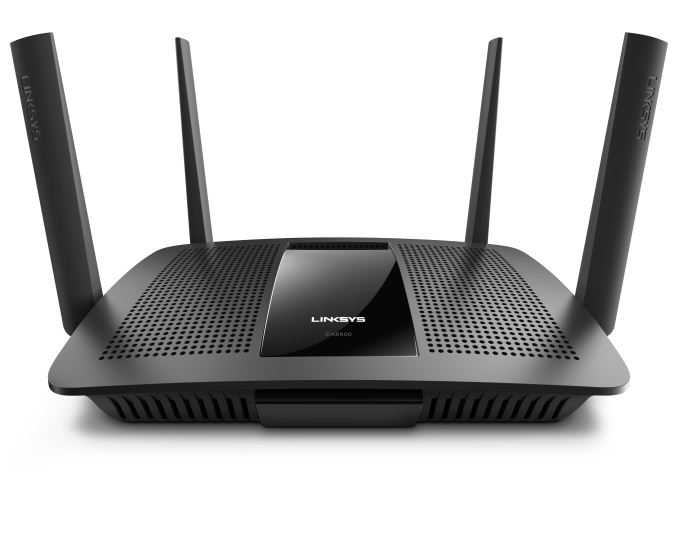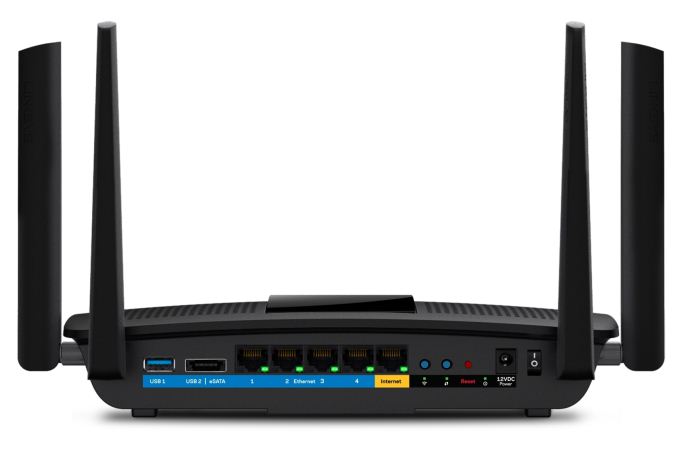Linksys EA8500 - First MU-MIMO Enabled 802.11ac Router Set to Ship
by Ganesh T S on May 7, 2015 7:00 AM EST- Posted in
- Networking
- Linksys
- 802.11ac
- Wi-Fi
- Qualcomm Atheros

Readers following our wireless networking coverage must be quite familiar with the developments in 802.11ac land. As a recap:
- The first 3-stream 802.11ac routers (based on the Broadcom BCM4706 chipset) started shipping in May 2012, with Buffalo Technologies and Netgear leading the way. There were marketed as AC1750 units (3x3 5 GHz providing up to 1300 Mbps and 3x3 2.4 GHz providing up to 450 Mbps). The street pricing of the AC1750 routers started to go down once Qualcomm started shipping their first-generation 802.11ac router platforms in products such as the TP-LINK Archer C7 in April 2013.
- In Q4 2013, a wave of AC1900 units started to hit the market. Netgear's Nighthawk R7000, a popular member in this series, still continues to sell well in the market. These units still used a 3x3 5 GHz radio for up to 1300 Mbps, but the 2.4 GHz had some proprietary Broadcom extensions (TurboQAM) to support up to 600 Mbps in an end-to-end Broadcom environment.
- In 2014, Quantenna began to bring their technology lead in the Wi-Fi space to the market with their Wave 2 4x4 802.11ac chipset. Despite being announced at CES 2014, the Asus RT-AC87U began to ship in July with the QSR1000 radio coupled with a Broadcom SoC. Netgear started to ship the same radio coupled with a Qualcomm IPQ8064 SoC in the Nighthawk X4 in September 2014. The QSR1000's Wave 2 feature set includes support for MU-MIMO, but neither of these routers shipped with MU-MIMO enabled in the firmware (citing lack of client support at that point of time). Given the 4x4 configuration, these routers were tagged as AC2350 / AC2400 units (600 Mbps in the 2.4 GHz band and 1733 Mbps in the 5 GHz band)
- In the midst of these Wave 2 product launches, Qualcomm announced plans for their Wave 2 802.11ac platforms (both routers and clients) in April 2014. Broadcom, being late to the Wave 2 party, decided to bring out the XStream platform with dual 5 GHz radios (six-stream configuration) also in April. They were able to get it quickly into the market too, with the Netgear Nighthawk X6 R8000 becoming available in June 2014.
- At CES 2015, we saw the first set of routers based on Qualcomm's QCA9880 4x4 Wave 2 802.11ac router platform getting announced. Vendors such as TP-LINK and TRENDnet were expecting their AC2600 class routers to ship towards the middle of the year.
Coming back to today's announcement regarding the EA8500, Linksys is becoming the first vendor to start shipping a QCA9980-based router. The important aspect here is that the router will ship with MU-MIMO enabled. Client devices with MU-MIMO enabled are also coming into the market just now (more on that in our detailed review). Hopefully, this announcement will spur both Netgear and Asus to enable MU-MIMO in the firmware for their Quantenna-based routers.
The salient features of the EA8500 router are listed below:
- 4x4 802.11ac with MU-MIMO and beamforming support
- QCA9980 radio + 1.4 GHz dual-core IPQ8064 SoC
- Simultaneous dual-band operation (5 GHz 802.11ac - 1733 Mbps, 5 GHz 802.11n - 600 Mbps, 2.4 GHz 802.11n - 800 Mbps)
- 1x USB 3.0, 1x USB 2.0 / eSATA
- 4x 1Gbps LAN, 1x 1Gbps WAN
- Adjustable antennas for optimal performance
One important point to note is that MU-MIMO capabilities will translate into real benefit only when there are multiple MU-MIMO-capable client devices talking to the router simultaneously. This will probably be a common scenario in enterprise Wi-Fi deployments soon. However, in a typical household, we would imagine that a situation involving multiple MU-MIMO clients is probably at least a good year away. Qualcomm is targeting an end-to-end play here, as the announcement made last year included a number of products in the client space with MU-MIMO capabilities.
Linksys is accepting pre-orders at $280 for the EA8500 today with shipments slated for May 10, 2015. Wide retail and e-tail availability is also expected starting next week. There is no doubt that MU-MIMO will be the most efficient way to boost Wi-Fi performance in the near future, and it is good that Linksys and Qualcomm are teaming together to accelerate its market adoption.
Source: Linksys











83 Comments
View All Comments
everdark81 - Friday, May 8, 2015 - link
That's not necessarily true, now that Comcast is rolling out 2gb/s service. Though that's as much about Comcast fleecing the non-tech savvy with marketing as it is an effort to push the boundaries and bring 10gig costs down.Samus - Sunday, May 10, 2015 - link
Please provide a link that offers any service beyond 1Gbps to any residence in the United States.IF you manage to actually find one, DO they provide (or even support) a media converter that is beyond a full duplex 1Gbps copper uplink?
This router, lacking the 10Gbps WAN, is easily future-proof for 5 years. Things aren't changing anytime soon.
If you have a service beyond 1Gbps, why are you looking at a Linksys router for your wireless thrills?
All of these comments cluelessly trolling this thing just piss me off.
hanssonrickard - Sunday, May 10, 2015 - link
Nbase-T is coming, hopefully pretty soon. That will give us 2.5 and 5 Gbit over cat5e and cat6.Sure, you need new hardware to support it.
Will be interesting to see how fast it will/can push the consumers to buy new stuf fto get faster home neworks and also push the service providers to provide faster options.
taltamir - Saturday, May 23, 2015 - link
Here you go, it took me 10 seconds on google to find ithttp://www.gizmag.com/fastest-home-internet-access...
10gbps ISP for home users
taltamir - Saturday, May 23, 2015 - link
oh, and here is for the UKhttp://motherboard.vice.com/read/this-rural-commun...
they started with gbps but also are rolling out 10gbps
and here is another one:
http://www.ispreview.co.uk/index.php/2014/03/gigac...
UtilityMax - Tuesday, May 12, 2015 - link
What planet do you live on? What do you need 10gbps WAN port? What's the point?toysareforboys - Saturday, May 16, 2015 - link
Who would use a commercial router for more than 1gbps WAN? Build an inexpensive PC and drop in two 10gbe cards for $35 each and load on your favourite router software, done.joeymore - Saturday, November 7, 2015 - link
I have a router which I can say a great deal for me since it has beamforming technology means that it'll direct more power in the direction of your devices to get them the signal power they need. Got that at http://www.consumerrunner.com/top-10-best-routers/Krysto - Thursday, May 7, 2015 - link
Open source firmware or bust. Way too many vulnerabilities in routers (whether on purpose or because they don't care to update them quickly). At least allow the community to fix them for you and audit their software.spikebike - Thursday, May 7, 2015 - link
My R7000 runs DDWRT and OpenWRT. Sure it's not quite the bleeding edge, but it's plenty fast for my heavy use. My uplink is 100 mbit, and I have a laptop, 2 desktops, 2 smart phones, tablet, and roku that are used regularly. It's been fast, stable, and I get a wifi connection even when I'm a few houses away. Not sure what I'd use the incremental performance for.